The Truth of Unusual Deaths under Military Expansion: Evidence from the Stable Isotopes of a Human Skull Ditch in the Capital City of the Early Shang Dynasty
Abstract
1. Introduction
2. Materials and Methods
3. Results
3.1. Radiocarbon Dating
3.2. Results of 87Sr/86Sr
3.3. Results of δ13C and δ15N
4. Discussion
5. Conclusions
Supplementary Materials
Author Contributions
Funding
Institutional Review Board Statement
Data Availability Statement
Acknowledgments
Conflicts of Interest
References
- Service, E.R. Origins of the State and Civilization: The Process of Cultural Evolution; Norton: New York, NY, USA, 1975; pp. 166–264. [Google Scholar]
- Antony, R.; Carroll, S.; Pennock, C.D. (Eds.) The Cambridge World History of Violence; Cambridge University Press: Cambridge, UK, 2020; Volume 3. [Google Scholar]
- Edwards, L.; Penn, N.; Winter, J. (Eds.) The Cambridge World History of Violence; Cambridge University Press: Cambridge, UK, 2020; Volume 4. [Google Scholar]
- Fagan, G.G.; Fibiger, L.; Hudson, M.; Trundle, M. (Eds.) The Cambridge World History of Violence; Cambridge University Press: Cambridge, UK, 2020; Volume 1. [Google Scholar]
- Gordon, M.S.; Kaeuper, R.W.; Zurndorfer, H. (Eds.) The Cambridge World History of Violence; Cambridge University Press: Cambridge, UK, 2020; Volume 2. [Google Scholar]
- Finucane, B.C. Trophy heads from Nawinpukio, Peru: Physical and chemical analysis of Huarpa-era modified human remains. Am. J. Phys. Anthropol. 2008, 135, 75–84. [Google Scholar] [CrossRef] [PubMed]
- Tubbs, R.S.; Loukas, M.; Shoja, M.M.; Apaydin, N.; Salter, E.G.; Oakes, W.J. The intriguing history of the human calvaria: Sinister and religious. Child’s Nerv. Syst. 2008, 24, 417–422. [Google Scholar] [CrossRef] [PubMed]
- Bello, S.M.; Parfitt, S.A.; Stringer, C.B. Earliest directly-dated human skull-cups. PLoS ONE 2011, 6, e17026. [Google Scholar] [CrossRef] [PubMed]
- Bello, S.M.; Wallduck, R.; Parfitt, S.A.; Stringer, C.B. An Upper Palaeolithic engraved human bone associated with ritualistic cannibalism. PLoS ONE 2017, 12, e0182127. [Google Scholar] [CrossRef]
- Santana, J.; Rodriguez-Santos, F.J.; Camalich-Massieu, M.D.; Martin-Socas, D.; Fregel, R. Aggressive or funerary cannibalism? Skull-cup and human bone manipulation in Cueva de El Toro (Early Neolithic, southern Iberia). Am. J. Phys. Anthropol. 2019, 169, 31–54. [Google Scholar] [CrossRef]
- Marginedas, F.; Rodriguez-Hidalgo, A.; Soto, M.; Bello, S.M.; Caceres, I.; Huguet, R.; Saladie, P. Making skull cups: Butchering traces on cannibalised human skulls from five European archaeological sites. J. Archaeol. Sci. 2020, 114, 105076. [Google Scholar] [CrossRef]
- Hao, B.X. On the Shang Dynasty skull drinking vessel unearthed in Zhengzhou. Huaxia Archaeol. 1992, 2, 94–100. (In Chinese) [Google Scholar]
- Henan Provincial Museum. Shang Dynasty rammed earth foundation and slave skulls found in Zhengzhou Shang City. Cult. Relics 1974, 9, 1–2. (In Chinese)
- Yan, W.M. The skull cup and the custom of scalping in Jiangou. Archaeol. Cult. Relics 1982, 2. (In Chinese) [Google Scholar]
- Sun, H.B. The skull excavated from the Bianjiashan site to discuss the skull cup custom and the relationship with the head hunting custom. Prehistory 2006, 00, 203–206. (In Chinese) [Google Scholar]
- Chen, X.C. The ancient Chinese custom of scalping. Cult. Relics 2010, 1, 48–55. (In Chinese) [Google Scholar]
- Zhang, X.L.; Qiu, S.H.; Cai, L.Z. Radiocarbon date of Zhengzhou and Yanshi Shang city. Cult. Relics Cent. China 2005, 1, 34–41. (In Chinese) [Google Scholar]
- Henan Provincial Institute of Cultural Heritage and Archaeology. Zhengzhou Shang City: Archaeological Excavation Report 1953–1985; Wenwu Press: Beijing, China, 2001. (In Chinese) [Google Scholar]
- Zou, H. Zhengzhou Shang city is the capital of Bo. Cult. Relics 1978, 2, 69–71. (In Chinese) [Google Scholar]
- Yang, Y.B. Re-discussing the age, character and related Issues of Zhengzhou Shang City. Huaxia Archaeol. 2004, 3, 52–70. (In Chinese) [Google Scholar]
- Sullivan, N.C. A preliminary study on human remains of Shang Dynasty in Zhengzhou Shang City. Relics Mus. 1993, 3, 3–4+23. (In Chinese) [Google Scholar]
- Huemoeller, K.P.D. Captivity for All? Slave Status and Prisoners of War in the Roman Republic. TAPA 2021, 151, 101–125. [Google Scholar] [CrossRef]
- Braund, D. The slave supply in classical Greece. In The Cambridge World History of Slavery; Bradley, K., Cartledge, P., Eds.; Cambridge University Press: Cambridge, UK, 2011; pp. 112–133. [Google Scholar] [CrossRef]
- Scheidel, W. The Roman slave supply. In The Cambridge World History of Slavery; Bradley, K., Cartledge, P., Eds.; Cambridge University Press: Cambridge, UK, 2011; pp. 287–310. [Google Scholar] [CrossRef]
- Huang, Z.Y. The problem of human sacrifice in ancient China. Archaeology 1987, 2, 159–168. (In Chinese) [Google Scholar]
- Huang, Z.Y. New materials on human sacrifice in ancient China. Archaeology 1996, 12, 53–61. (In Chinese) [Google Scholar]
- Campbell, R.B. Blood, Flesh and Bones: Kinship and Violence in the Social Economy of the Late Shang. Ph.D. Thesis, Harvard University, Cambridge, MA, USA, 2007. [Google Scholar]
- Wolin, D. Decapitated heads as Elite visual culture in late Shang China. Camb. Archaeol. J. 2022, 32, 189–204. [Google Scholar] [CrossRef]
- Zhu, F.H. The social patterns of Shang and Zhou dynasties from the perspective of production methods. Hist. Res. 2000, 2, 16–18. (In Chinese) [Google Scholar]
- Zhao, J.X. A Rejoinder to Prof. Duan Zhongqiao’s critical comment on the comment on “The theory of five social formations”. J. Peking Univ. (Philos. Soc. Sci.) 2006, 2, 58–66. (In Chinese) [Google Scholar]
- Ren, H.B. A review and rethinking on the social patterns of the Yin and Shang Dynasty. Hist. Bimon. 2021, 2, 13–19. (In Chinese) [Google Scholar]
- Xu, Y.H. Chinese slave society in the light of the operating mechanism of slave society. Trends Recent Res. Hist. China 2021, 3, 50–55. (In Chinese) [Google Scholar]
- Liu, X.L. A brief discussion on slaves in Shang Dynasty—Also on the social identity of human sacrifices. Qilu J. 1990, 4, 83–86. (In Chinese) [Google Scholar]
- Wang, Y.C. A Comparative and Evolutionary Study of the Custom From Human To Figurine Sacrifices in Pre-Qin and Han Dynasties. Master’s Thesis, Shaanxi Normal University, Xi’an, China, 2013. (In Chinese). [Google Scholar]
- Li, B.Q. On the early Xia Culture—From the relationship between the dynastic changes of the Xia, Shang and Zhou dynasties and archaeological cultural changes. Cult. Relics Cent. China 2000, 1, 11–14. (In Chinese) [Google Scholar]
- Wang, X. From the distribution of Shang culture, see the Shang capital and Shang city. Cult. Relics Cent. China 1991, 1, 39–42. (In Chinese) [Google Scholar]
- Chen, Z.Y. The northern expansion of Shang Culture in the Central Plains and the northern expansion of Shang Dynasty power. Huaxia Archaeol. 2008, 1, 96–103. (In Chinese) [Google Scholar]
- Han, J.Y. Early China on the Erlitou-Erigang period Culture. Cent. Plains Cult. Res. 2014, 2, 5–12. (In Chinese) [Google Scholar]
- Chen, H. A Study on the Southward Expansion of the Central Plain Cultures from Late Longshan to Erligang Period. Ph.D. Thesis, Wuhan University, Wuhan, China, 2019. (In Chinese). [Google Scholar]
- Chang, K.C. Ancient trade as economics or as ecology? In Ancient Cicilization and Trade; Sabloff, J.A., Lamberg-Karlovsky, C.C., Eds.; University of New Mexico Press: Albuquerque, NM, USA, 1975; pp. 211–224. [Google Scholar]
- Research Shows that the Origin of Mass Human Sacrifices at Yinxu Were Captives Not Slaves. Available online: http://art.people.com.cn/GB/n1/2016/0726/c206244-28585629.html (accessed on 8 August 2022).
- Shelach, G. The Qiang and the question of human sacrifice in the late Shang period. Asian Perspect. 1996, 35, 1–26. [Google Scholar]
- Tang, J.G.; Niu, H.R. A study to the human sacrificial pits at the Yinxu royal cemetery and the Qiang people recorded in the Oracle Bone Inscriptions concerning the victim killing in ritual performance. Sino-Humanit. 2013, 00, 411–431. (In Chinese) [Google Scholar]
- Tang, J.G.; Tang, Y.Y. On the relationship between Yinxu human sacrificial pits and divinations about Qiang sacrifice in oracle bone inscriptions. Cult. Relics Cent. China 2014, 3, 24–28. (In Chinese) [Google Scholar]
- Hou, L.L.; Wei, D.; Richards, M.P. Diversification origins of the populations from the Nancheng cemetery during proto-Shang culture (ca. 2000~1600 BC) evidenced by strontium isotope analysis. Quat. Sci. 2021, 41, 235–246. (In Chinese) [Google Scholar]
- Chen, X. Research on the Bone Chemical Characteristics of Human Bones from the Western Zhou Dynasty Unearthed from the Ruiguo Cemetery in Liangdaicun. Master’s Thesis, Northwest University, Xi’an, China, 2012. (In Chinese). [Google Scholar]
- Zhao, C.Y.; Yuan, J.; He, N. Strontium isotope analysis of archaeological fauna from the taosi site, xiangfen county, shanxi province. Quat. Sci. 2011, 31, 22–28. (In Chinese) [Google Scholar]
- Zhao, C.Y.; Yang, J.; Yuan, J.; Li, Z.P.; Xu, H.; Zhao, H.a.; Chen, G.L. Strontium isotope analysis of archaeological fauna at the Erlitou site. Sci China Earth Sci 2012, 55, 1255–1259. [Google Scholar] [CrossRef]
- Zhao, C.Y.; Lu, P.; Yuan, J.; Fang, Y.M. Elemental and strontium isotope ratio analysis of animal remains excavated from the Wadian site, Yuzhou, Henan. Archaeology 2012, 12, 89–96. (In Chinese) [Google Scholar]
- Yin, R.C.; Zhang, J.Z.; Yang, X.Y. Preliminary study of prehistoric human migration based on Sr isotope analysis from Jiahu relics. Quat. Sci. 2008, 28, 50–57. (In Chinese) [Google Scholar]
- Fang, F. Indentity and Source of the Skulls Unearthed from Skulls Ditch, Zhengzhou Shang City. Ph.D. Thesis, University of Science and Technology of China, Hefei, China, 2016. (In Chinese). [Google Scholar]
- Zhao, C.Y.; Li, Z.P.; Yuan, J. Strontium isotope analysis of horse and pig tooth enamels excavated from the Yinxu site, Anyang, Henan Province. Cult. Relics South. China 2015, 3, 77–80+112. (In Chinese) [Google Scholar]
- Zhao, C.Y.; Hu, S.M.; Sun, Z.Y.; Shao, J.; Yang, M.M. Strontium isotope analysis of animal tooth enamels excavated from Shimao site, Shaanxi, China. Archaeol. Cult. Relics 2016, 4, 128–133. (In Chinese) [Google Scholar]
- Zhao, C.Y.; Wang, M.H.; Ye, M.L. Strontium isotope analysis of human teeth and bones from the Lajia site in Qinghai province. Acta Anthropol. Sin. 2016, 35, 212–222. (In Chinese) [Google Scholar]
- Zhao, C.Y. The characterization of strontium isotope ratio in human bones and teeth from the Heshuiguo site. In Proceedings of the Thirteenth Annual Conference of Chinese Vertebrate Zoology, Hohhot, China, 25–27 August 2012; Dong, W., Ed.; China Ocean Press: Beijing, China, 2012; pp. 267–272. (In Chinese). [Google Scholar]
- Zhao, C.Y.; Hu, S.M.; Yang, M.M.; Guo, X.N.; Yang, T. Analysis of strontium isotope ratio of animal remains from the jiadamao site in northern Shaanxi area. Quat. Sci. 2022, 42, 59–68. (In Chinese) [Google Scholar]
- Tang, Z.H.; Wang, X.Y.; Chen, X.L.; Tian, Y.Q.; Hu, S.M.; Yu, J.; Yuan, J. Strontium isotope study of cattle and horse tooth enamel at the Beidoufang location of the Xuechi sacrificial site. Archaeol. Cult. Relics 2020, 6, 122–125. (In Chinese) [Google Scholar]
- Bentley, R.A.; Price, T.D.; Stephan, E. Determining the ‘local’ Sr-87/Sr-86 range for archaeological skeletons: A case study from Neolithic Europe. J. Archaeol. Sci. 2004, 31, 365–375. [Google Scholar] [CrossRef]
- Cucchi, T.; Hulme-Beaman, A.; Yuan, J.; Dobney, K. Early Neolithic pig domestication at Jiahu, Henan Province, China: Clues from molar shape analyses using geometric morphometric approaches. J. Archaeol. Sci. 2011, 38, 11–22. [Google Scholar] [CrossRef]
- Xiang, H.; Gao, J.Q.; Cai, D.W.; Luo, Y.B.; Yu, B.Q.; Liu, L.Q.; Liu, R.R.; Zhou, H.; Chen, X.Y.; Dun, W.T.; et al. Origin and dispersal of early domestic pigs in northern China. Sci. Rep. 2017, 7, 5602. [Google Scholar] [CrossRef]
- Brown, T.A.; Nelson, D.E.; Vogel, J.S.; Southon, J.R. Improved collagen extraction by modified Longin method. Radiocarbon 1988, 30, 171–177. [Google Scholar] [CrossRef]
- Ambrose, S.H. Preparation and characterization of bone and tooth collagen for isotopic analysis. J. Archaeol. Sci. 1990, 17, 431–451. [Google Scholar] [CrossRef]
- Richards, M.P.; Hedges, R.E. Stable isotope evidence for similarities in the types of marine foods used by Late Mesolithic humans at sites along the Atlantic coast of Europe. J. Archaeol. Sci. 1999, 26, 717–722. [Google Scholar] [CrossRef]
- Deniro, M.J. Postmortem preservation and alteration of invivo bone-collagen isotope ratios in relation to paleodietary reconstruction. Nature 1985, 317, 806–809. [Google Scholar] [CrossRef]
- Reimer, P.J.; Bard, E.; Bayliss, A.; Beck, J.W.; Blackwell, P.G.; Ramsey, C.B.; Buck, C.E.; Cheng, H.; Edwards, R.L.; Friedrich, M.; et al. IntCal13 and Marine13 radiocarbon age calibration curves 0–50,000 years cal BP. Radiocarbon 2013, 55, 1869–1887. [Google Scholar] [CrossRef]
- Yue, Z.W.; Wang, X.R.; He, Y.L.; Tang, J.Q.; Niu, S.S.; Gu, F. 2003–2004 Excavation of a Shang bronze foundry-site at Xiaomintun in Anyang city, Henan. Archaeology 2007, 1, 14–25+12. (In Chinese) [Google Scholar]
- Cheung, C.; Jing, Z.C.; Tang, J.G.; Weston, D.A.; Richards, M.P. Diets, social roles, and geographical origins of sacrificial victims at the royal cemetery at Yinxu, Shang China: New evidence from stable carbon, nitrogen, and sulfur isotope analysis. J. Anthropol. Archaeol. 2017, 48, 28–45. [Google Scholar] [CrossRef]
- Zhang, X.L.; Xu, G.D.; He, Y.L.; Qiu, S.H. Carbon and nitrogen stable isotope analysis of human bones unearthed from Yinxu Tomb 54. Archaeology 2017, 3, 100–109. (In Chinese) [Google Scholar]
- Wang, Q.; Tang, J.G.; Yue, H.B.; Yue, Z.W. Study of Late Shang dynasty plant remains excavated from three locations of Anyun site: Liujiazhuang, Dasikongcun and Xinanzhuang. Cult. Relics South. China 2018, 3, 124–131. (In Chinese) [Google Scholar]
- Institute of Archaeology Chinese Academy of Social Sciences. Report on the Excavations at Yinxu; Cultural Relics Publishing House: Beijing, China, 1987. (In Chinese) [Google Scholar]
- Zhangjiakou Archaeological Team. The main achievements of the archaeology of the Xia and Shang periods in Weixian. Archaeol. Cult. Relics 1984, 1. (In Chinese) [Google Scholar]
- Tang, Y.M. Investigation of the Shang Dynasty site of Beilonggong in Gaocheng. Cult. Relics 1985, 10, 31–35. (In Chinese) [Google Scholar]
- Henan Provincial Administration of Cultural Heritage. Excavation Report of Xiaqiyuan Culture Cemetery—In Liu Zhuang, Hebi; Zhao, X.P., Ed.; Science Press: Beijing, China, 2012. (In Chinese) [Google Scholar]
- Kong, P. A Study on the Settlement Archaeology of Xia and Shang Dynasties in the Southest Foothills of Taihang Mountain. Master’s Thesis, Henan University, Kaifeng, China, 2022. (In Chinese). [Google Scholar]
- Guo, R.J. The relationship between the natural environment of Yinxu and the Yin dynasty. Huaxia Archaeol. 1999, 3, 87–90. (In Chinese) [Google Scholar]
- Yang, P. A study of the interaction between the natural environment and society at Yinxu. Yellow River Yellow Earth Yellow Race 2021, 4, 43–48. (In Chinese) [Google Scholar]
- Liu, L.; Chen, X.C. The form of early states in China, a discussion of the relationships between the center and periphery in the Erlitou and Erligang periods. Anc. Civiliz. 2002, 1, 71–134. (In Chinese) [Google Scholar]
- Hou, W.D. Urbanization of Zhengzhou Shang city. Cult. Relics Cent. China 2018, 3, 36–45+62. (In Chinese) [Google Scholar]
- Sun, D.H.; Luo, P.; Zhang, Y. Report on the excavation of the Xiaqiyuan site in Cixian. Acta Archaeol. Sin. 1979, 2, 185–214+273–278. (In Chinese) [Google Scholar]
- Wang, L.X.; Hu, B.H. Research on the southward movement of the Xiaqiyuan Culture. A Collect. Stud. Archaeol. 2011, 00, 179–193. (In Chinese) [Google Scholar]
- Hou, W.D. Research on the social changes in the central plains during the fourth period of the Erlitou Culture. Cult. Relics Cent. China 2020, 3, 51–56. (In Chinese) [Google Scholar]
- Tang, J.G.; Yue, H.B.; He, Y.L.; Yue, Z.W. Report on the excavation of No.1 house-foundation in the palace area of the Huanbei Shang City, Anyang, Henan Province. Archaeology 2003, 5, 401–407. (In Chinese) [Google Scholar]
- He, Y.L.; Tang, J.G. Report on the excavation of No.2 house-foundation in the palace area of the Huanbei Shang City, Anyang, Henan Province. Archaeology 2010, 1, 9–22+97–100+113. (In Chinese) [Google Scholar]
- He, Y.L.; Yue, H.B. Review of ten years of Huanbei Shang City. J. Natl. Mus. China 2011, 12, 6–19. (In Chinese) [Google Scholar]
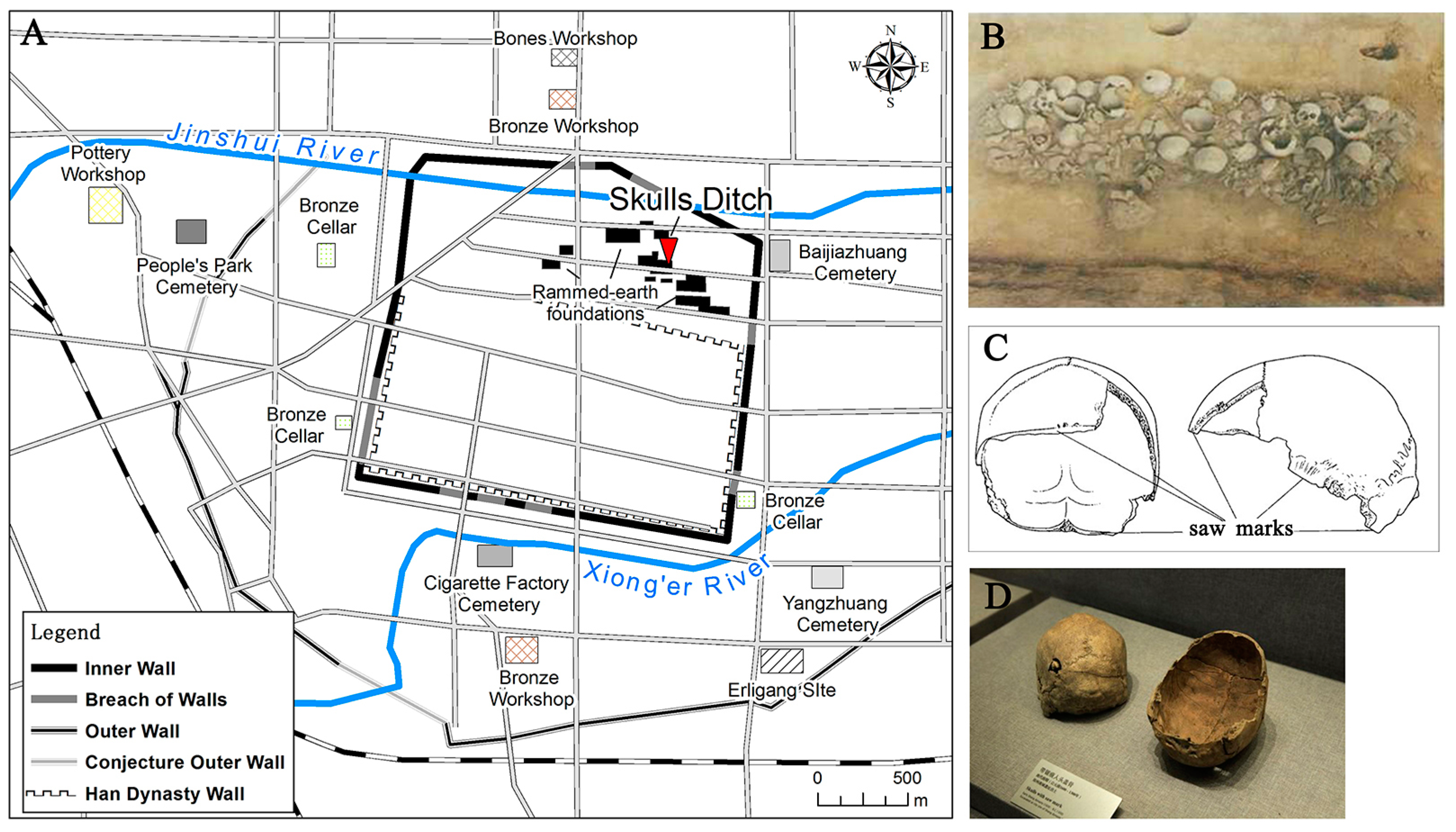
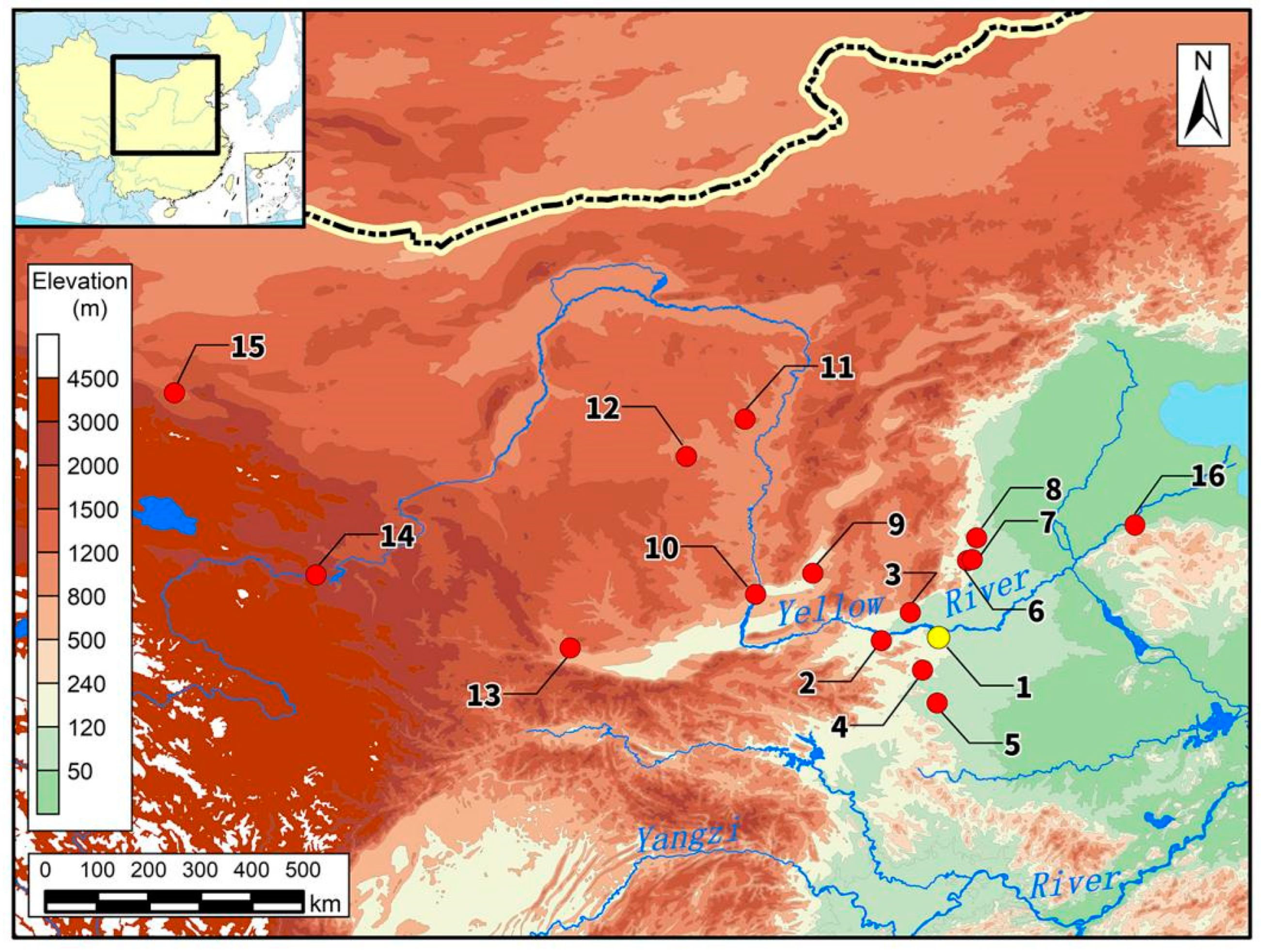
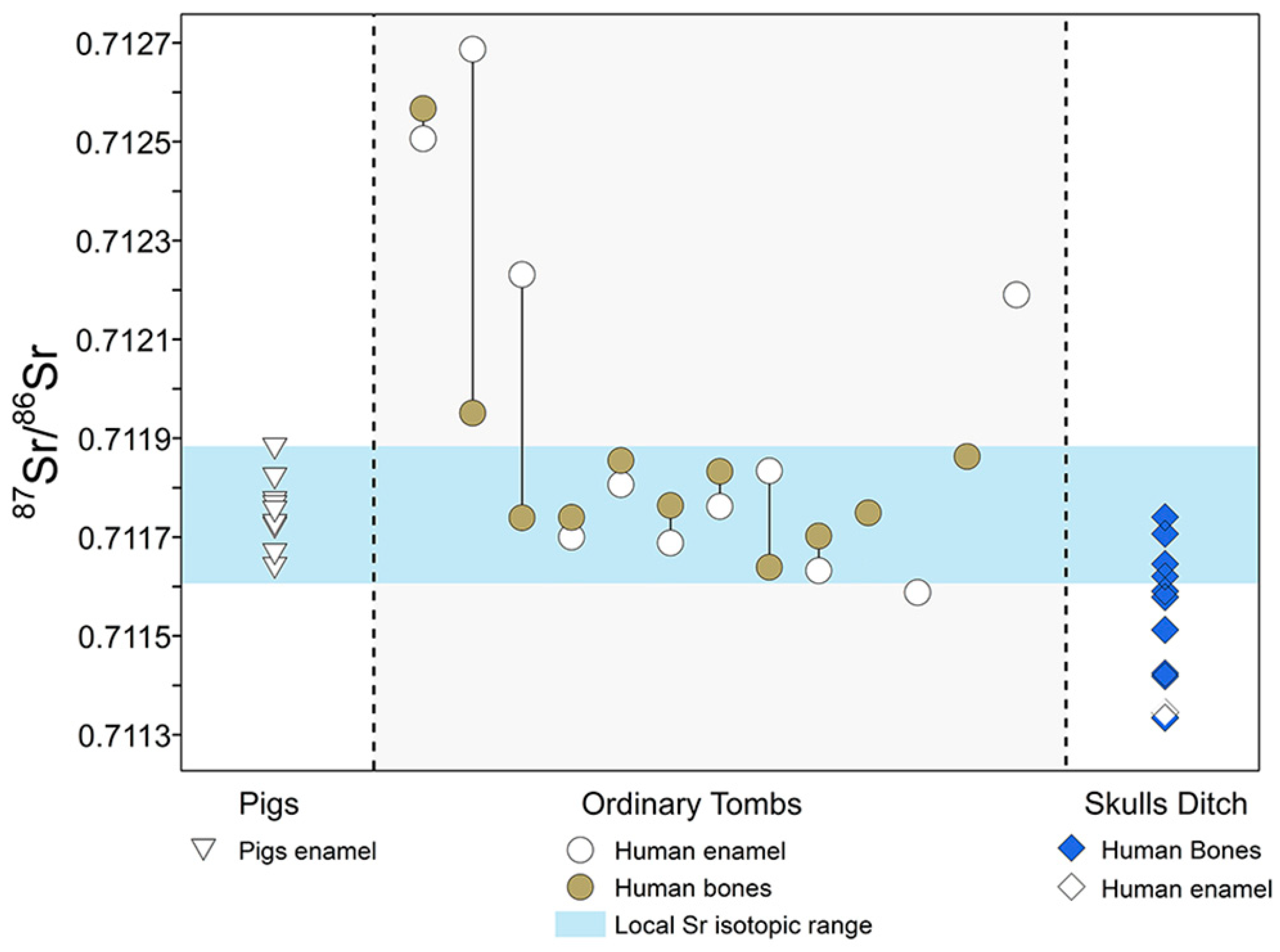
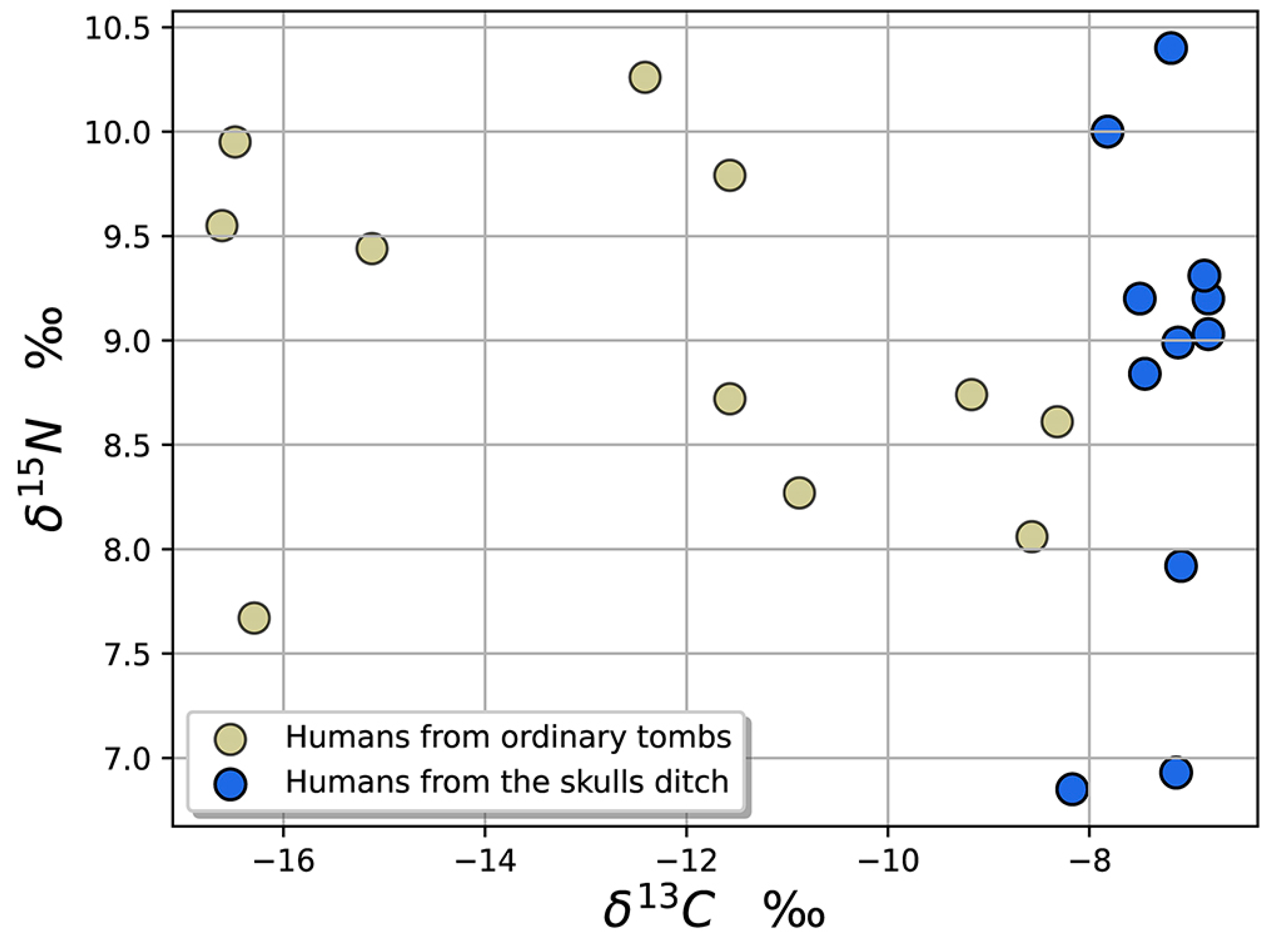
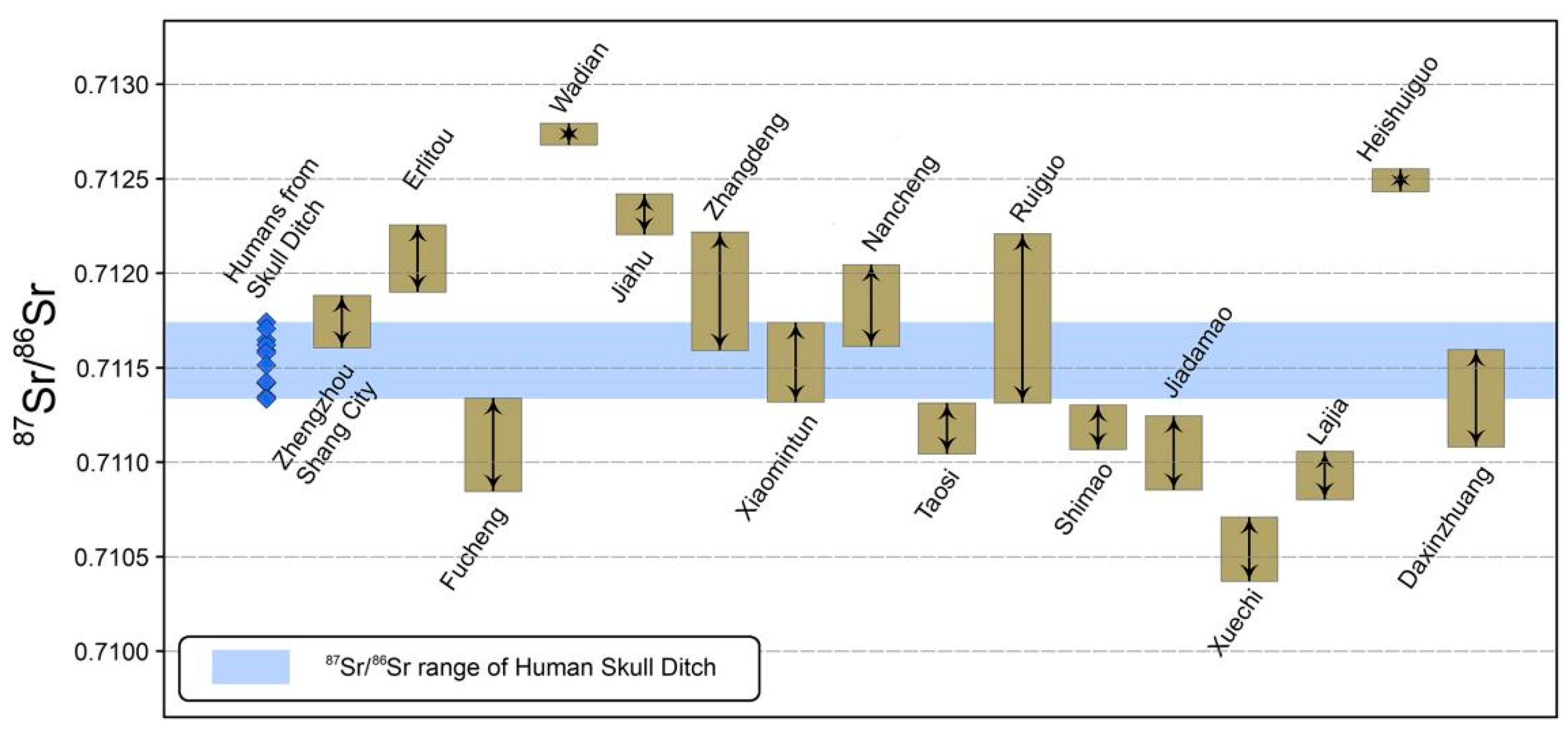
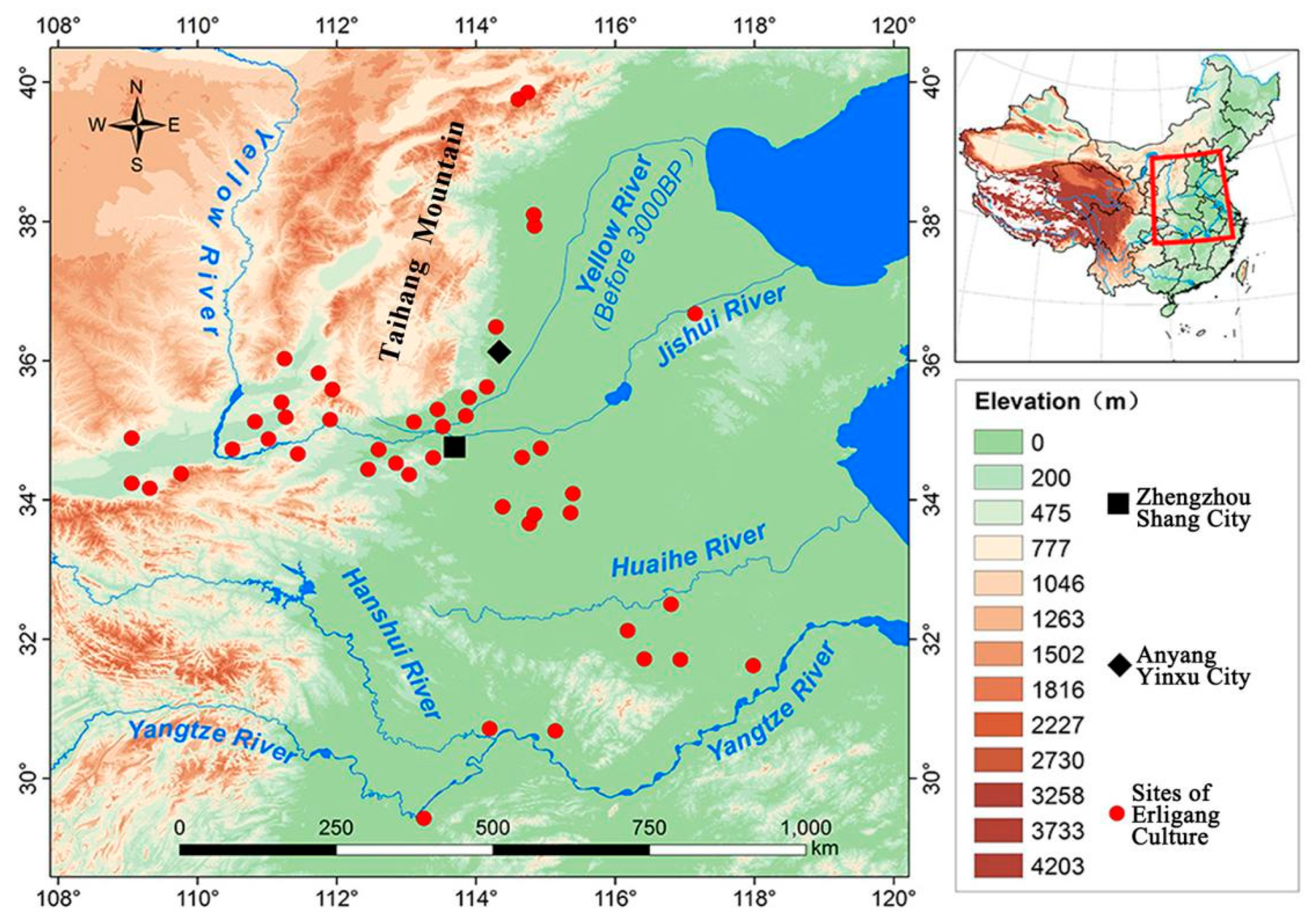
| Lab Code | Sample Type | Radiocarbon Age (14C yr BP) | cal. Years BC (1σ-Range) | Probability Distribution (%) | cal. Years BC (2σ-Range) | Probability Distribution (%) |
|---|---|---|---|---|---|---|
| 001 | Human skull | 3070 ± 30 | 1392–1335 | 60.5 | 1414–1260 | 99.0 |
| 1324–1288 | 39.5 | 1241–1235 | 1.0 |
Publisher’s Note: MDPI stays neutral with regard to jurisdictional claims in published maps and institutional affiliations. |
© 2022 by the authors. Licensee MDPI, Basel, Switzerland. This article is an open access article distributed under the terms and conditions of the Creative Commons Attribution (CC BY) license (https://creativecommons.org/licenses/by/4.0/).
Share and Cite
Fang, F.; Liao, J.; Zeng, X.; Zhang, J. The Truth of Unusual Deaths under Military Expansion: Evidence from the Stable Isotopes of a Human Skull Ditch in the Capital City of the Early Shang Dynasty. Genes 2022, 13, 2077. https://doi.org/10.3390/genes13112077
Fang F, Liao J, Zeng X, Zhang J. The Truth of Unusual Deaths under Military Expansion: Evidence from the Stable Isotopes of a Human Skull Ditch in the Capital City of the Early Shang Dynasty. Genes. 2022; 13(11):2077. https://doi.org/10.3390/genes13112077
Chicago/Turabian StyleFang, Fang, Jingwen Liao, Xiaomin Zeng, and Juzhong Zhang. 2022. "The Truth of Unusual Deaths under Military Expansion: Evidence from the Stable Isotopes of a Human Skull Ditch in the Capital City of the Early Shang Dynasty" Genes 13, no. 11: 2077. https://doi.org/10.3390/genes13112077
APA StyleFang, F., Liao, J., Zeng, X., & Zhang, J. (2022). The Truth of Unusual Deaths under Military Expansion: Evidence from the Stable Isotopes of a Human Skull Ditch in the Capital City of the Early Shang Dynasty. Genes, 13(11), 2077. https://doi.org/10.3390/genes13112077





